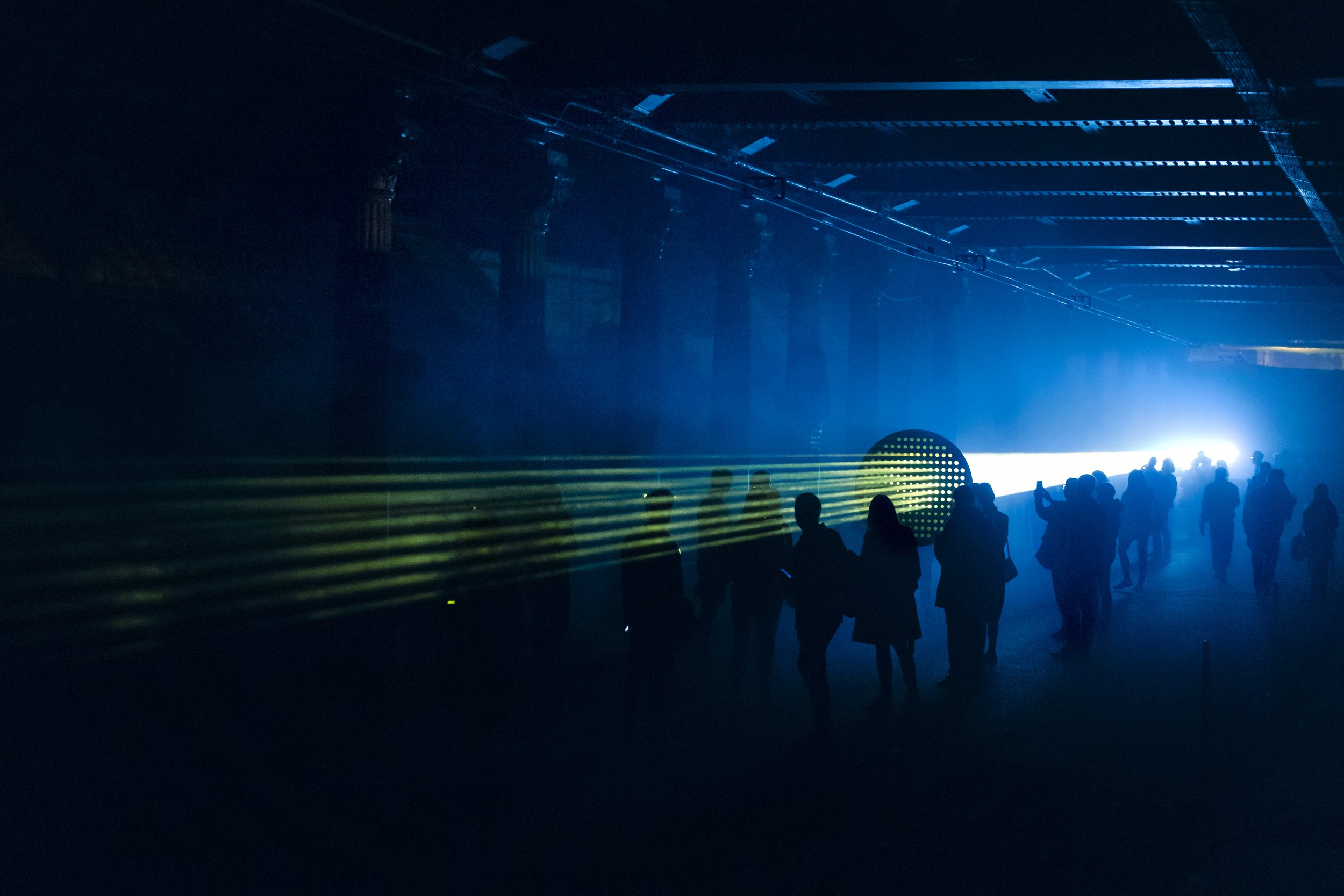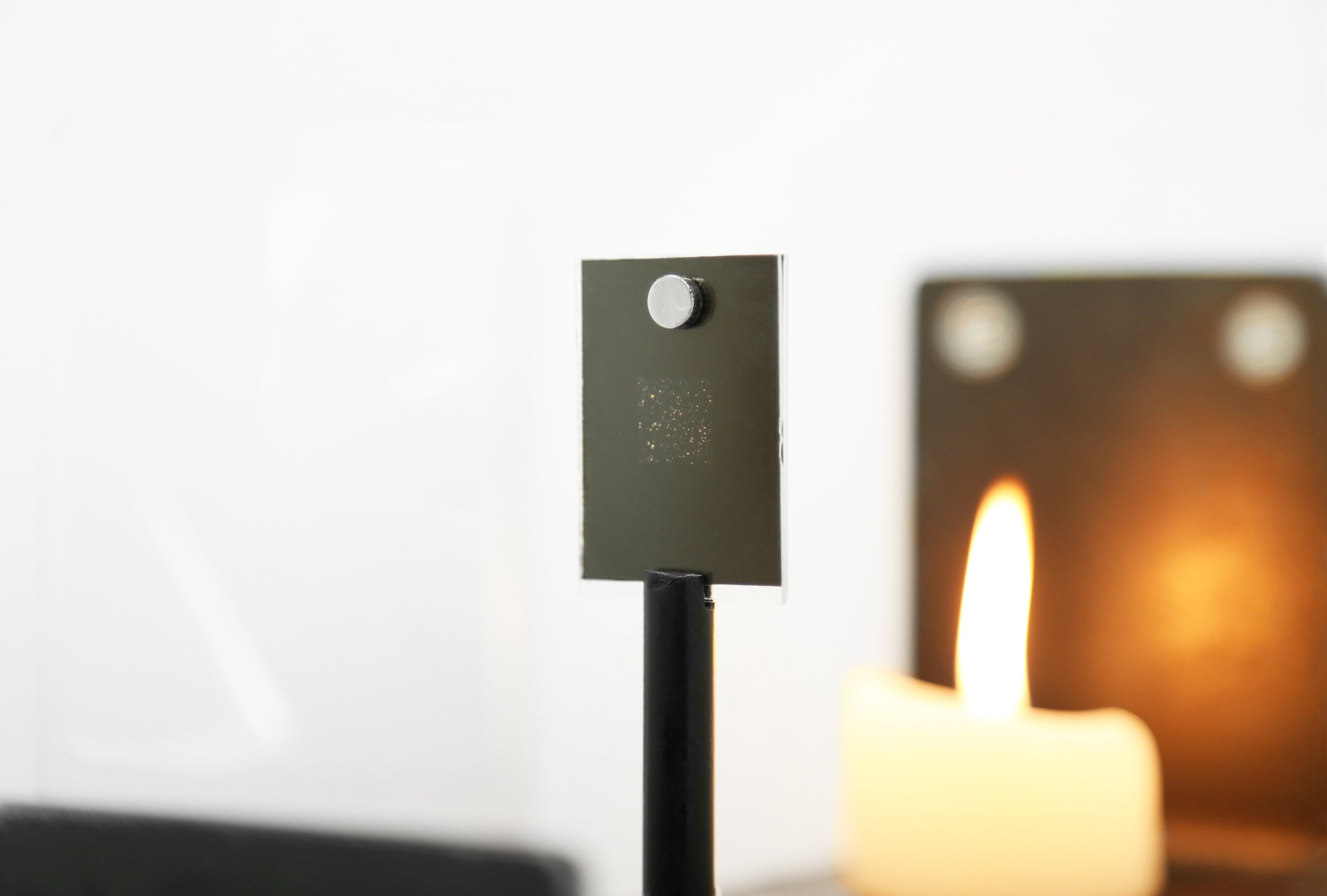10 SPOTLIGHT (EXTENDED): FÉLICIE D’ESTIENNE D’ORVES
ASTRONOMICALLY GROUNDED
Is it possible to actually experience an exploding star? How does a sunset look on Mars? And, what might it be like to join the sunlight on its journey to Earth? Greek-born, Paris-based artist, Félicie d’Estienne d’Orves, approaches these questions through many of her frequently immersive works; combining light, sculpture, and new technologies to take a phenomenological approach to distant realities.
What began as a fascination with the cosmos, sharpened into a direct response to astrophysical phenomena in 2008 when d’Estienne d’Orves began collaborating with Fabio Acero, a Supernova specialist and astrophysicist at the AIM/CEA laboratories (see: A Miner, 2020). Together they realised Supernova (2011), a cycle of light projected onto smoke in a Plexiglasbox (see: D’Orves, n.d.). Accompanied by an experimental sound piece by Laurent Dailleau (ibid.), it aimed not only to depict the rational, scientific reality of an exploding star, but also to create a hypnotic experience simulating the magnificent illumination created by a supernova. This collaborative process has gone on to underscore d’Estienne d’Orves’ more recent films, installations, and objects which are derived in equal measure from celestial activity, scientific research,and the artist’s preoccupation with painted light.
‘My work is linked with the field of classical painting, particularly the Impressionists’, d’Estienne d’Orves suggests. ‘By observing the light effect on a still life or a landscape, the classical painters questioned the illusion of a permanent reality. I am trying to stop time by capturing light in nature, just as Monet did.’ She is, of course, working in a different technological and intellectual context, where observational equipment is more widely available, and our understanding of the cosmos has evolved. Still, d’Estienne d’Orves engages with enduring themes, including the perception of reality in both a physical and metaphysical sense.
In 2019, the Centre Pompidou in Paris commissioned Continuum, a 52-minute audio-visual performance developed in collaboration with several scientists, including Le Laboratoire de Météorologie Dynamique (LMD), with specialist advice from Dr Dan McLeese (NASA’s Jet Propulsion Laboratory at Caltech USA) , Dr Mark Lemmon (Texas A&M University USA), François Forget, Senior Research Scientist at LMD Jussieu, and Engineer and Programmer Guillaume Jacquemin (Felicity Tippex, n.d.). The performance reconstructs a sunset as seen from Mars, to the sound of French composer Éliane Radigue’s seminal Koumé (1993), a slowly unwinding drone-based electronic composition which ebbs and flows in intensity, and forms the third part of her ‘Trilogy of Death’ (ibid.; Something Curated, 2019). Radigue was inspired by the Tibetan Book of the Dead (ibid.), and d’Estienne d’Orves explains that she was trying to understand these Tibetan notions of life and death: that the Buddhist continuum of existence is portrayed in 'the idea of the horizon, where the earth does not stop and the sky does not finish at that intersection'.
While electronic music drove the atmosphere of the work, scientists informed its imagery: demystifying the strange colourings on Mars – red sky by day, blue sky at sunset – as caused by the scattering of photons and their interactions with dust particles (see: Thomas, 2001); and deconstructing imagery of the earth’s own sunset to derive the equivalent astronomical parameters and atmospheric data on Mars, so ensuring the film’s authenticity. Viking II’s images of Utopia Planitia (see: NASA, n.d.), along with surveillance of other areas, also formed the basis for the shallow reliefs of the contemporaneous Martian Sun series (2019; see Rose, 2019). ‘Just as the Impressionists went into the fields to capture natural light’, explains d’Estienne d’Orves, ‘with Continuum and the Martian Sun series, I worked with landscapes millions of kilometres away.’
The Martian Sun bas-reliefs feature images of the topography of Mars. Two were displayed in the solo show Deep Fields at Cibrian Gallery, Spain in 2019. The exhibition’s title was inspired by the Hubble Deep Field, containing around 10,000 galaxies (see: ESA, n.d.) which, according to d’Estienne d’Orves, ‘testifies to other dimensions of reality and literally projects thought onto new horizons.’ Gale Crater (Yellow Knife) and Jezero, both 2019, were illuminated with LED lights, programmed so that their intensity corresponded with the sun’s activity on Mars. They relate the three-dimensional, physical reality of Mars, as informed by the latest NASA technology, to ancient middle-eastern reliefs from thousands of years BC. That feeds neatly into d’Estienne d’Orves’ interest in ‘playing with oppositions’. It also invites ‘cosmic meditation which questions our knowledge of reality’, an idea which is reinforced by the use of a simple candle to light a photographic slide of the Hubble.
Indeed, according to the artist, it is astonishing to witness ‘the illusion of the sunset in its astrophysical space with [one’s own] vision, and feel it would have been the same for anyone throughout history – say, in the Middle Ages’. Her Light DNA series (2019) accentuates this sense of awe. Supernova: Cas A (2019), Supernova: Kepler (2019) and Supernova: Tycho (2019) are backlit, white glass lightboxes. Each is coloured in stripes corresponding with their chemical composition. Unaided human sightings of supernovae are rare – though one opportunity lasted some eight months in India around 4,500 BC (Murdin and Murdin, 1985) – yet scientific knowledge allows us to understand more of what is actually happening at the end of a star’s life.
In another example of dramatic illumination, Sun (~8 mn), 2017, lasts the eight minutes it takes for light to arrive on Earth from the Sun (see: Newton, 1952 [1704]). It forms part of the Light Standard Series which tracked timings similarly for Venus, Mars and Uranus. In a 100-metre-long exhibition space in Houston, d’Estienne d’Orves created a human-size disc with several holes through which light was emitted. The disc then travelled along the room proportionate to the speed of light, darkening as it went, and so took eight minutes to traverse the metal track from one end of the room to the other, mapping time on the body as visitors walked along with the movement of the disc. This also had the effect of contrasting physical time with the speed of contemporary life. d’Estienne d’Orves worked with experimental sound composer Franck Vigroux to accentuate the experience: she describes how ‘when you are on your own with the work it can be very peaceful and quiet … and when there are lots of visitors it gives another idea to the piece which I didn’t think about when I made it: life is dependent on the sun, we need our star, so there is a sense when it darkens with a crowd of people that it is the end of humanity.’
Again bringing the celestial down to earth, d’Estienne d’Orves created Venus and Mars in Le Havre in 2015, as a way of asking what if the outward-looking port ‘turned its gaze even further, or set its sights higher?’ She converted a power plant into a space beacon, so that its two smokestacks ‘exhaled’ light at variable intervals adjusted to the ‘light time’ of the two planets – the time it would take light to travel from Venus to Earth or Mars to Earth. Consistent with her interest in classical painting, d’Estienne d’Orves’ equates the planetary wonder she evokes to the ancient wonder of the gods depicted in Sandro Botticelli’s Venus and Mars, 1483 (see: The National Gallery, n.d.).
Looking at the future, d’Estienne d’Orves is making a permanent installation for Leuven, Belgium, which responds to it as the city of the renowned mathematician, astronomer, and Professor of Physics at the Catholic University of Louvain: Georges Lemaître. A contemporary of Einstein, Lemaître made the first substantial strides within a newly formalised discipline of cosmology in the 1930’s (e.g. Kragh and Lambert, 2007). His hypotheses of the ‘primeval atom’ (which later became known as ‘the big bang’) (see: Lemaître, 1931) and the expanding universe (see: Lemaître, 1934) were both contentious during his lifetime (Appolloni, 2011). ‘He created a shift in scientific theory on par with Copernicus’, explains d’Estienne d’Orves. In his honour, she will install Primeval Atom – a series of 100 footpath medallions throughout the city – as a metaphor for the limits of our observable universe. Each metal disc will correspond to a galaxy and be placed according to its distance from Earth, as symbolised by a larger medallion in the middle of Leuven. That central point will incorporate an LED display programmed to reveal the trajectory of naturally occurring astronomical objects, as taken from ephemerides which draw on several hundred years of stellar activity. D’Estienne d’Orves describes how she is ‘trying to map the idea of an expanding universe onto the entire city of Leuven, with an ensemble of small medallions as well as the main interactive disc which will scan the sky over the city and refer to different positions within the galaxies.’ To celebrate the opening, a laser beam projecting out from the central library will be directed to the furthest known galaxy GN-z11 which is 13.4 billion light years from earth (see: Jiang et al., 2021).
In contrast, Khil Khor, 2021, drills into microscopic levels of activity in a conjunction of three inspirations: contemporary atomic physics, the ancient philosophy of Tibetan Buddhism, and Hungarian Op artist Victor Vasarely’s research in wave-corpuscle duality of matter at a quantum scale, particularly his Ondulatoires series of the 1950’s. The phrase ‘khil khor’ translates to the Tibetan centre or circle, referring to the mandala – originally made from coloured sand – as a representation of ephemerality and the metaphysical cosmos (Toft, 2000). Presented as a platform floor piece, Khil Khor’s 15 interconnected rectangular metal plates each contain a shallow level of water. As the plates shift, the water is moved to invoke how quantum particles have no well-defined positions, and can only be described by a wave function. The plates function independently yet form parts of the whole as they project alternative perspectives – aspects which remind us of the organised chaos of existence expounded by the Buddhist order. The work is once again accompanied by Éliane Radigue’s experimental music: this time Kailasha, which honours the pilgrimage around the base of the Mount Kailash, sacred to Tibetans (Something Curated, 2019).
Felicié d’Estienne d’Orves’ particular achievement is to utilise sophisticated technology, not only to bring the galaxy to the gallery space, but also to introduce ancient ideas about our metaphysical reality. Moreover, just as the land artists of the 1970s offered new areas of artistic exploration beyond the canvas, she pushes the boundaries of what we understand to be the direct opposite of land: the sky above.
For more on d’Estienne d’Orves and her work, please visit www.feliciedestiennedorves.com.
The permanent installation of Primeval Atom opened in Leuven, Belgium in October 2021, as part of the Knal! Festival of the Big Bang.
Le Lieu Unique Art Centre in Nantes will host a solo exhibition in March 2022.
All images and video shown courtesy of © Felicié d’Estienne d’Orves.














